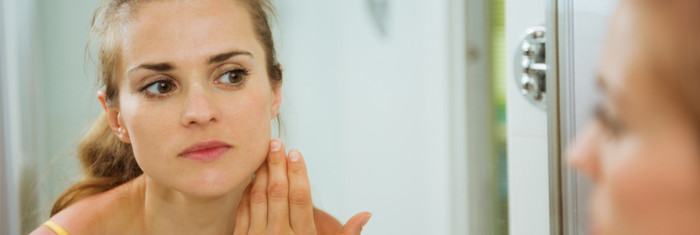
Do you see your dermatologist for an annual check-up? Good for you! Unfortunately, in terms of developing melanoma, a lot can happen to your skin in 12 months. This is especially true if you
- Spend a lot of time in the sun for work or play
- Fail to wear protective gear (hats, clothing) when you’re in the sun
- Fail to use and reapply broad spectrum sunscreen
Many health problems signal their presence with pain. Skin cancer may not, but there are tell-tale indications that spots on the skin may be cause for concern. In this article, the skin specialists at Platinum Dermatology offer an easy, step-by-step process you can use at home to examine your body, so cancer doesn’t get a chance to take hold.
Early Detection: Platinum Dermatology’s 11-Point Skin Cancer Self-Exam
Skin cancer can develop almost anywhere on the body. Platinum Dermatology recommends that you set aside time for a thorough, thoughtful self-examination that starts at your scalp and ends on the soles of your feet and aims at noticing any changes to your skin that you haven’t noticed before.
Using just your eyes…
- Examine your face and head – Check your scalp, face, nose, lips, and mouth. Check the inside and outside of your ears, front and back.
- Examine your hands and wrists – Check the back of your hands and the palms, too. Don’t forget to look at the skin that is between your fingers and under your nails. Check the skin on your wrists.
- Examine your arms – Look at the skin on the front and back of your forearms.
Now it’s time to stand with your back to a full-length mirror with a hand-held mirror in front of you. Together they will allow you to - Examine the sides of your upper arms and your underarms.
- Examine your neck chest and torso, including the underside of the breasts. (This is important for women and for men with excess breast tissue).
- Examine the back of your neck, shoulders, and upper back.
- Examine your lower back, buttocks, and the backs of both legs.The final part of your self-exam is performed while you are seated:
- Examine the front and sides of your legs from shin to thigh.
- Examine your ankles.
- Examine the tops and bottoms of your feet, along with the skin between the toes and under the toenails.
- Finally, examine your genitalia by sitting on a stool and propping up each leg in turn.
Dermatologists Offer the #1 Way to Prevent Skin Cancer
Checking your skin on a consistent basis will help you spot changes as soon as they occur. When that happens, skin irregularities should be taken seriously and discussed with a professional without delay. If you have a spot on your skin that is causing you concern, don’t hesitate to contact your general practitioner.
It’s much better to be told that a spot is “Nothing to worry about,”
than to hear “You should have come in sooner.”
Your GP can refer you to a specialist dermatologist. At Platinum Dermatology, our skin specialists are uniquely qualified to provide a full, head-to-toe skin examination. These exams can lead to early detection and cure, and help patients avoid invasive surgery.
According to the Melanoma Institute of Australia, more than 1,200 people will die from skin cancer this year. It is the genuine hope of everyone at Platinum Dermatology that the information in this article will help save lives. We encourage you to share it with your friends and family.
If you would like to know more about skin cancer, age spots, and ways cosmetic treatments can keep you beautiful and disease-free, we urge you to contact Platinum Dermatology on 02 8014 6500 or use the contact form on this page to schedule an appointment at our practice in Ultimo.
[costhetics-gallery template='teaser' slug='head-to-toe-11-places-to-check-your-body-for-skin-cancer' /] [costhetics-concern-related-treatments slug='head-to-toe-11-places-to-check-your-body-for-skin-cancer' /]